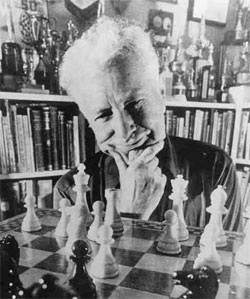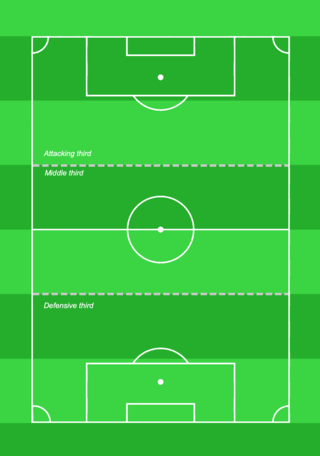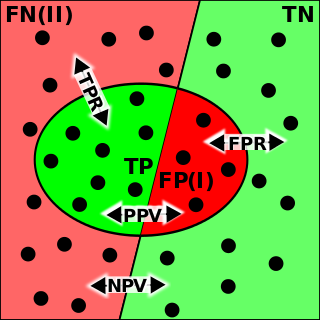
The Elo rating system is a method for calculating the relative skill levels of players in zero-sum games such as chess. It is named after its creator Arpad Elo, a Hungarian-American physics professor.
In probability theory, odds provide a measure of the likelihood of a particular outcome. When specific events are equally likely, odds are calculated as the ratio of the number of events that produce that outcome to the number that do not. Odds are commonly used in gambling and statistics.
Pythagorean expectation is a sports analytics formula devised by Bill James to estimate the percentage of games a baseball team "should" have won based on the number of runs they scored and allowed. Comparing a team's actual and Pythagorean winning percentage can be used to make predictions and evaluate which teams are over-performing and under-performing. The name comes from the formula's resemblance to the Pythagorean theorem.

Team tactics as well as individual skills are integral for playing association football. In theory, association football is a very simple game, as illustrated by Kevin Keegan's namely assertion that his tactics for winning a match were to "score more goals than the opposition". Tactical prowess within the sport is nonetheless a craftsmanship of its own, and one of the reasons why managers are paid well on the elite level. Well-organised and ready teams are often seen beating teams with more skillful players on paper. Manuals and books generally cover not only individual skills but tactics as well.
Credibility theory is a branch of actuarial mathematics concerned with determining risk premiums. To achieve this, it uses mathematical models in an effort to forecast the (expected) number of insurance claims based on past observations. Technically speaking, the problem is to find the best linear approximation to the mean of the Bayesian predictive density, which is why credibility theory has many results in common with linear filtering as well as Bayesian statistics more broadly.
A parlay, accumulator, combo bet, or multi is a single bet that links together two or more individual wagers, usually seen in sports betting. Winning the parlay is dependent on all of those wagers winning together. If any of the bets in the parlay lose, the entire parlay loses. If any of the plays in the parlay ties, or "pushes", the parlay reverts to a lower number of wagers with the payout odds reducing accordingly. Parlay bets are high-risk, high-reward; linking the possibilities drastically reduces the chance of the bet paying off overall. The benefit of the parlay is that there are much higher pay-offs, although as usual, casinos and bookkeepers offering parlays often exploit the poor calculation of gamblers by not increasing the pay-out as much as the odds truly demand, with the effect of the house edge increasing in parlays.
The outcome bias is an error made in evaluating the quality of a decision when the outcome of that decision is already known. Specifically, the outcome effect occurs when the same "behavior produce[s] more ethical condemnation when it happen[s] to produce bad rather than good outcome, even if the outcome is determined by chance."

The 1995 Football League Cup Final was a football match played between Liverpool and Bolton Wanderers on 2 April 1995 at Wembley Stadium, London. It was the final match of the 1994–95 Football League Cup, the 35th staging of the Football League Cup, a football competition for the 92 teams in the Premier League and The Football League. Liverpool were appearing in their seventh final, they had previously won four and lost twice. Bolton were appearing in their first final.

The 2005 UEFA Super Cup was an association football match between Liverpool of England and CSKA Moscow of Russia on 26 August 2005 at Stade Louis II, Monaco, the annual UEFA Super Cup contested between the winners of the UEFA Champions League and UEFA Cup. Liverpool were appearing in the Super Cup for the fifth time, having won the competition in 1977 and 2001. CSKA Moscow were appearing in the Super Cup for the first time, the first Russian team to appear in the competition.
Shot Quality is a term used in the statistical analysis of ice hockey to indicate the probability that a given shot will result in a goal, based on factors such as the distance of the shot taken, the type of shot and other factors such as the number of players on the ice for each team. It is used to isolate the impact of goaltending performance. By comparing the number of goals allowed to the total of the Shot Quality figures for each shot against, a goaltender can be rated relative to average performance across the league.
Thorold Charles Reep was a British analyst credited with creating the long ball game, which has characterised English football.

The 2001 FA Charity Shield was the 79th FA Charity Shield, an annual football match played between the winners of the previous season's Premier League and FA Cup. The match was contested between Liverpool, winners of the 2000–01 FA Cup and Manchester United, who won the 2000–01 Premier League on 12 August 2001. It was the first Shield match to be held at the Millennium Stadium following the closure of Wembley Stadium for reconstruction. It was also the final time that the match was played under the FA Charity Shield name, as it was renamed to the FA Community Shield the following year.

The 1981 Intercontinental Cup was an association football match between Liverpool of England and Flamengo of Brazil on 13 December 1981 at the National Stadium in Tokyo, Japan. The annual Intercontinental Cup was contested between the winners of the European Cup and Copa Libertadores. Flamengo qualified for the Intercontinental Cup for the first time following their Copa Libertadores Cup success. Liverpool were also appearing in their first Intercontinental Cup. They had declined to take part in 1977 and 1978 after they won the European Cup. On 27 October 2017, following a meeting held in Kolkata, India, the FIFA Council recognised the winners of Intercontinental Cup as world champions.
Advanced Football Analytics was a website dedicated to the analysis of the National Football League (NFL) using mathematical and statistical methods. The site's lead author was noted football researcher and analyst Brian Burke. Burke is a regular contributor to The New York Times' NFL coverage, The Washington Post's Commanders coverage, and supplies research for other notable publications and writers.
Statistical Football prediction is a method used in sports betting, to predict the outcome of football matches by means of statistical tools. The goal of statistical match prediction is to outperform the predictions of bookmakers, who use them to set odds on the outcome of football matches.
Winning and Score Predictor (WASP) is a calculation tool used in cricket to predict scores and possible results of a limited overs match, e.g. One Day and Twenty 20 matches.

The evaluation of binary classifiers compares two methods of assigning a binary attribute, one of which is usually a standard method and the other is being investigated. There are many metrics that can be used to measure the performance of a classifier or predictor; different fields have different preferences for specific metrics due to different goals. For example, in medicine sensitivity and specificity are often used, while in computer science precision and recall are preferred. An important distinction is between metrics that are independent on the prevalence, and metrics that depend on the prevalence – both types are useful, but they have very different properties.
In ice hockey, analytics is the analysis of the characteristics of hockey players and teams through the use of statistics and other tools to gain a greater understanding of the effects of their performance. Three commonly used basic statistics in ice hockey analytics are "Corsi" and "Fenwick", both of which use shot attempts to approximate puck possession, and "PDO", which is often considered a measure of luck. However, new statistics are being created every year, with "RAPM", regularized adjusted plus-minus, and "xG", expected goals, being created very recently in regards to hockey even though they have been around in other sports before. RAPM tries to isolate a players play driving ability based on multiple factors, while xG tries to show how many goals a player should be expected to add to their team independent of shooting and goalie talent.
Sports analytics are collections of relevant historical statistics that can provide a competitive advantage to a team or individual. Through the collection and analysis of these data, sports analytics inform players, coaches and other staff in order to facilitate decision making both during and prior to sporting events. The term "sports analytics" was popularized in mainstream sports culture following the release of the 2011 film, Moneyball, in which Oakland Athletics General Manager Billy Beane relies heavily on the use of baseball analytics, building upon and extending the established practice of Sabermetrics, to build a competitive team on a minimal budget.
Pitch quantification is the attempt to describe the quality of a pitch using a single numeric value based on quantifiable aspects of an individual baseball pitch. There are two main kinds of pitch quantification. The first is outcome oriented. This means that the result of a given pitch is a component used to calculate the overall numeric value that describes the quality of the pitch. The other kind of pitch quantification does not consider the outcome of a pitch when calculating quality. Rather, it is batter independent. Its quality can be assessed without regard to what the batter does with the pitch.







